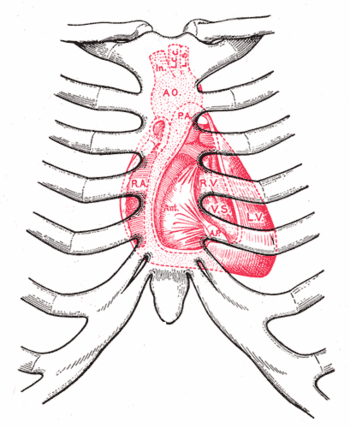Heart sound
In medicine, heart sounds are the "sounds heard over the cardiac region produced by the functioning of the heart. There are four distinct sounds: the first occurs at the beginning of systole and is heard as a "lubb" sound; the second is produced by the closing of the aortic valve and pulmonary valve and is heard as a "dupp" sound; the third is produced by vibrations of the ventricular walls when suddenly distended by the rush of blood from the heart atria; and the fourth is produced by atrial contraction and ventricular filling."[1]
Normal heart sounds
A diagram of the cardiac cycle is available and helps understand the normal heart sounds.[2]
S1
S1, which originates from closure of the mitral and tricuspid valves is normally louder than S2 at the cardiac apex (fifth left intercostal space).[3]
S2
S2 is normally louder than S1 at the cardiac base (second left intercostal space).[4]
The S2 is composed of A2 and P2:
- A2 originates from closure of the aortic valve
- P2 originates from closure of the pulmonic valve, is best heard at the cardiac base (second left intercostal space), and is quieter than A2.
References
- ↑ Anonymous (2024), Heart sound (English). Medical Subject Headings. U.S. National Library of Medicine.
- ↑ (1990) “The First Heart Sound”, Walker HK, Hall WD, Hurst JW: Clinical methods: the history, physical, and laboratory examinations (in English), 3rd. London: Butterworths. LCC RC71 .C63. ISBN 0-409-90077-X. “See image of cardiac cycle at http://www.ncbi.nlm.nih.gov/bookshelf/br.fcgi?book=cm&partid=333&rendertype=figure&id=A684” Library of Congress
- ↑ McGee, Steven R. (2007). “The First and Second Heart Sounds”, Evidence-Based Physical Diagnosis, 2nd. Philadelphia: Saunders, 418. ISBN 1-4160-2898-6.
- ↑ McGee, Steven R. (2007). “Auscultation of the Heart: General Principles”, Evidence-Based Physical Diagnosis, 2nd. Philadelphia: Saunders, 415. ISBN 1-4160-2898-6.
- ↑ McGee, Steven R. (2007). “The First and Second Heart Sounds”, Evidence-Based Physical Diagnosis, 2nd. Philadelphia: Saunders, 422. ISBN 1-4160-2898-6.
- ↑ 6.0 6.1 Harris A, Sutton G (November 1968). "Second heart sound in normal subjects". British heart journal 30 (6): 739–42. PMID 5718983. PMC 487796. [e] PubMed Central
Bibliography
- Drummond Rennie; David Simel (2008). THE RATIONAL CLINICAL EXAMINATION: EVIDENCE-BASED CLINICAL DIAGNOSIS (Jama & Archives Journals). McGraw-Hill Professional. ISBN 0-07-159030-7.
- McGee, Steven R. (2007). Evidence-Based Physical Diagnosis: Text with BONUS PocketConsult Handheld Software. Philadelphia: Saunders. ISBN 1-4160-2898-6.
- (1990) Walker HK, Hall WD, Hurst JW: Clinical methods: the history, physical, and laboratory examinations (in English), 3rd. London: Butterworths. LCC RC71 .C63. ISBN 0-409-90077-X. Library of Congress
